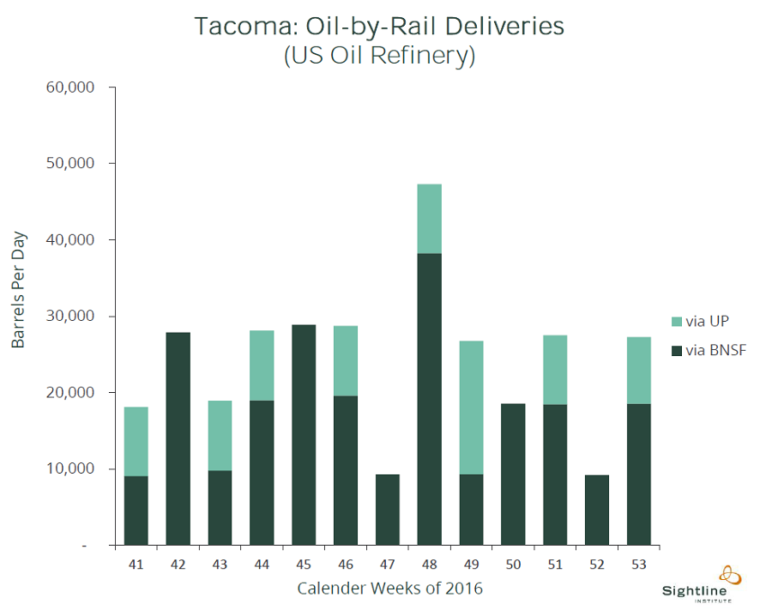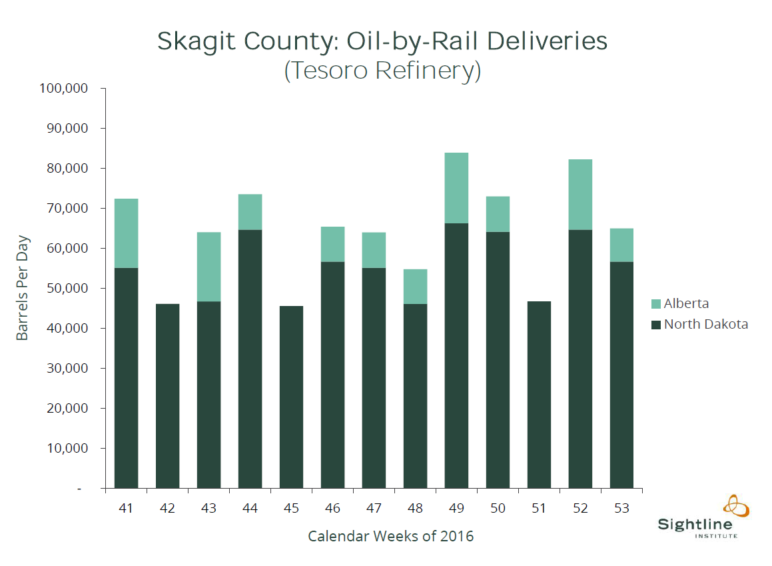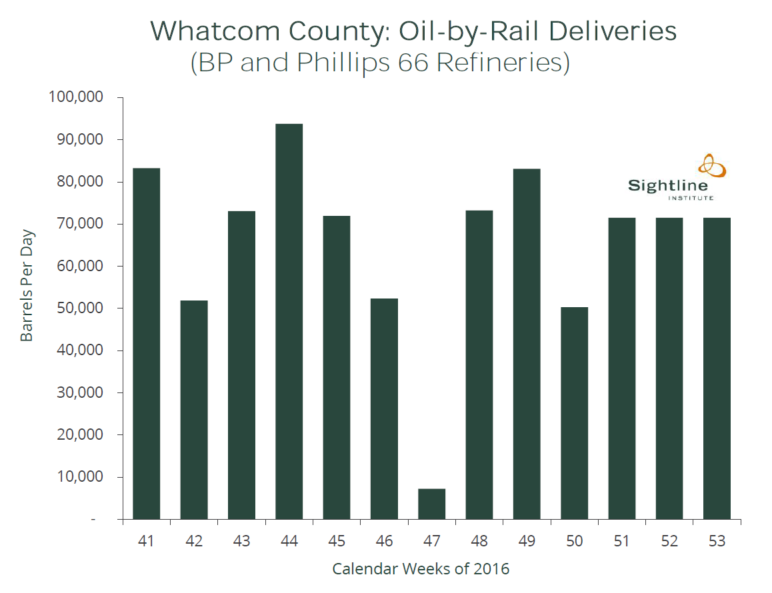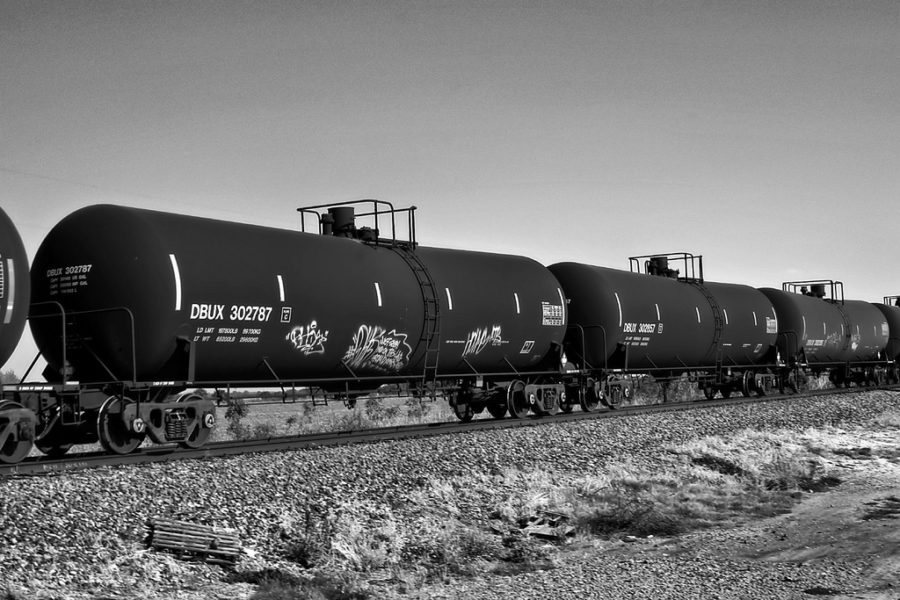#WA refineries supplied themselves with +150,000 barrels of oil per day by rail delivery.
Last week, the Washington Department of Ecology published its first quarterly report on oil transport in the state, including important new information on oil train shipments. Although the publication presents the data in a confusing manner that makes it difficult for the public to understand exactly how much oil is moving, and where, it nonetheless adds considerably to our understanding of oil-by-rail in the Northwest. By piecing together the figures in the new report with what we already know about the industry, we can develop a clearer understanding of how oil trains move throughout the state.
We now know that in the last quarter of 2016:
- Quantity: Oil trains delivered more than 14.7 million barrels of crude oil via 21,603 rail cars to Washington’s 5 refineries. Overall, these refineries supplied themselves with an average of 154,469 barrels of oil per day, roughly one-quarter of their total refining capacity, by rail delivery.
- Rail Corporations: It appears that BNSF Railway dominated oil train movements in Washington, handling roughly 96 percent of the cargo. Union Pacific (UP) contributed only about 4 percent and likely delivered that oil solely to the refinery at Tacoma.
- Origins and Destinations: No loaded oil trains transited the mountain passes over the Cascades. Nearly all the oil, 94 percent, originated in North Dakota, passed through Spokane, and ran along the Columbia River Gorge before turning north to destinations on Puget Sound. A minor fraction, 6 percent, came from Alberta and entered Washington by way of Whatcom County before traveling south along the Sound to the Tesoro Refinery at Anacortes.
All oil trains in Washington are destined for one of the state’s five refineries located on the shores of Puget Sound. The smallest of these, US Oil, is located in the heart of Tacoma’s industrial area. It accepted an average of 24,355 barrels per day, supplying roughly 58 percent of its rated capacity of 42,000 barrels.

Tacoma was the only site that took delivery of oil trains moved along UP rail lines, the railroad responsible for the catastrophic explosion in Mosier, Oregon, in June 2016. In fact, the wrecked train was bound for Tacoma.
The report also reveals that Washington shipped out 135,000 barrels of crude oil by marine vessel, roughly the amount that would be carried by one standard tank barge. This shipment may have originated from Tacoma in November, when during week 48 the small US Oil Refinery there received the equivalent of 47,000 barrels per day, considerably more oil than its refining capacity could have handled.
Most oil trains continued north, passing through the state’s biggest population centers en route to refineries on the north Sound. The first destination along the way is the Tesoro Refinery at Anacortes, which accepted about 5 million barrels of crude oil by rail—more than 64,000 barrels per day on average—that originated in North Dakota and arrived in Skagit County from the south. Tesoro was the intended destination for the oil train that derailed under Seattle’s Magnolia Bridge in July 2014.

The Tesoro Refinery was the only facility that accepted oil trains from Alberta and therefore the only site to accept rail deliveries of medium and heavy crude oil. (All of the oil that Washington received from North Dakota was classified as light crude.) Based on the reported gravities of the oil, it does not appear that Tesoro accepted any rail deliveries of tar sands oil, a very dense (and very polluting) oil extracted in Alberta.
There is evidence that Tesoro may be selling a portion of its oil-by-rail deliveries to the neighboring Shell Refinery, so we don’t know whether all this oil was ultimately refined by Tesoro. Shell had intended to construct an oil train unloading facility, but its plans were scuttled by a robust opposition movement, procedural delay, and worsening economic conditions. Moreover, the future of oil train deliveries to Tesoro remains uncertain, as the local Swinomish tribe is suing BNSF in federal court for breaching the terms of an easement that the railroad obtained across tribal land. In January 2016, a judge allowed the suit to proceed, ruling that BNSF has breached its contract.
The remainder of the oil trains continued north to the BP and Phillips 66 Refineries in Whatcom County. Together these refineries accepted 6 million barrels of crude oil, an average of nearly 66,000 barrels per day. All of it was light oil from North Dakota that moved along BNSF’s rail lines in Washington.

Notoriously hazardous—prone to derailments, spills, and occasional explosions—the Northwest oil-by-rail industry is scarcely more than four years old. Only now with the publication of Washington Department of Ecology’s first ever quarterly report does the public have a reasonably accurate sense of just how much oil is moving by rail, and where. Going forward, we can expect to see updated oil transportation reports once per quarter, summaries that will provide the public with important insight into pipelines and marine vessels, as well as oil trains.
Notes and methods: Sightline’s analysis counts data only from weeks 41 to 53; we exclude the partial-week data for week 40 that is included in the Ecology report. We converted Ecology’s weekly figures into barrels per day, consistent with industry standards. More of Sightline’s leading analysis of Northwest oil-by-rail can be found in our blog series and in our July 2015 report on the industry’s plans.


Comments are closed.